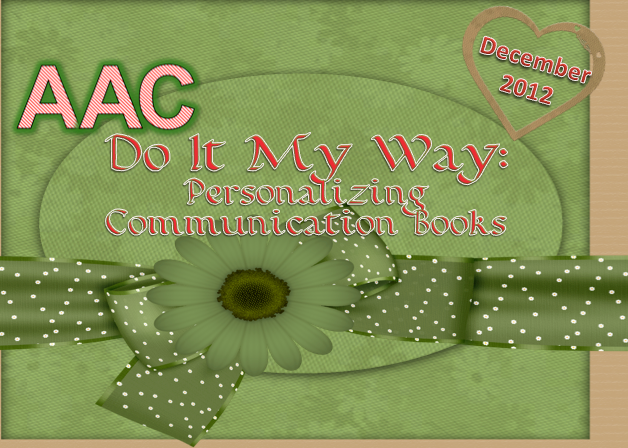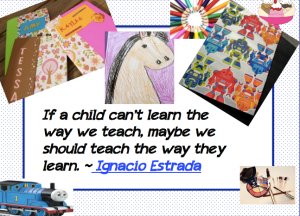Do It My Way: Personalizing Communication Books

The topic of communication books was introduced this month. We will continue to think about the multitude of decisions to make as we design individual communication books. Obviously, content is the most important issue, but we are often reminded that function and form must go together.
Carole gave some great examples of reasons to make the books appealing and personal. I had a situation this week that illustrated this concept perfectly. We continue to learn from the ‘learners’ that we are teaching. I know a little girl with autism who most people think does not care about her peers or how things look. She uses some natural speech and a no-tech communication book. She uses the communication book during her speech-language therapy sessions but only inconsistently outside of the therapy room. She has not expressed interest in taking the communication book with her and although she has some specific visual supports at home and school there has been no real ‘push’ to follow through with the communication book in these settings (but that is for another post).
The communication book has always been decorated with her name in pretty letters but that has been about it. This semester though, a new graduate student clinician had an idea (have we said that we love working with graduate students lately?). Each session, there was an activity that focused on decorating a part of the communication book (front corner, back corner, inside cover, etc.). Of course, there were goals to the decorating activities. Here were some:
5 Goals While Decorating Communication Book (activity was no more than 5-10 minutes)
- Requesting using an attribute (adjective). How it was done: For colors of paints, crayons, glitter, etc. (okay, glitter was a bit extreme)
- Commenting on other’s objects and actions. How it was done: Clinician decorated her own communication book (for Aided Language Input (ALI) and did some really ‘funky’ things to promote comments. See Go Ape- 10 Commenting Temptations.
- Explanation using 2 sentences. How it was done: Wrote and communicated a set of instructions on how to do different art process (i.e using glitter, tye dye, laminate, etc.)
- Choice making for future events. How it was done: A choice board was used to decide weekly and monthly topics. At the beginning, choice making between 2 options later, options increased and were added to monthly calendar.
- Rate preferences to help increase self advocacy skills. How it was done: All choices and decisions about the communication book were rated (themes, type of art process , how it looked, level of satisfaction, etc.). A journal was kept of preferences, rating scales, and even of changing of ratings over time (who likes the same things the same way forever).
At the end of our semester, the book did not look ‘classically’ beautiful but it had representation from many of this learner’s interests. And guess what happened: All of a sudden this young girl started requesting to take the communication book home AND to school. All of a sudden, she was not letting mom forget it when they went out. She even ‘showed it’ to the teacher. The only differences in the book was ‘how it looked and felt’ and that it was created collaboratively (a vocabulary word learned in the process). She even began ‘explaining’ parts of the book to her classmates……… All this for a young girl who didn’t care….

Filed under: PrAACtical Thinking
This post was written by Robin Parker

2 Comments
OMGoodness! Love this story! What a great way to help that young take ownership and pride in her communication book!
Heartwarming yet makes total sense!